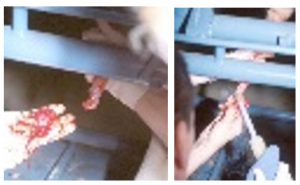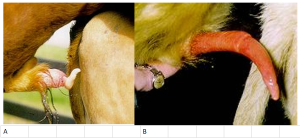Food Animal Male Urogenital Surgery
Penile Issues
Many bull penis issues can be either 1) managed in the field and 2) very challenging to manage even in a referral institution.
Persistent frenulum
The frenulum is a band that connects the free end of the penis and prepuce in young animals. It should rupture as the animal matures; however, it doesn’t, it causes ventral bending of the distal penis and animals are less successful at breeding. This lesion also occurs in llamas and pigs. In llamas, it can persist for over 2 years before it ruptures. A persistent frenulum is considered an inherited condition. Bulls with a persistent frenulum should only be used for breeding if all male calves are castrated.
Treatment is a simple resection; however, the frenulum is vascularized. The bull is held in a chute or restrained on a tilt table. The penis is exteriorized manually and a towel clamp placed on the dorsal apical ligament to maintain a hold on the penis. [Options: Pudendal block to naturally exteriorize the penis; use a gauze to hold the penis.] Standard scrub is used to clean the area and the attachment site infused with lidocaine. If the transection site is close to the urethra, the urethra can be catheterized with a 10Fr dog urinary catheter to help identify the urethra and minimize risk of trauma. A transfixation ligature is placed at each end of the frenulum using 0 absorbable suture and the frenulum transected. Any additional hemorrhage should be controlled before the animal is set free. Sexual rest is indicated for 2-4 weeks.
Video at Merck Veterinary Manual
Images 3-14 at the Drost project
Fibropapilloma
Fibropapilloma (“warts”) is the most common penile tumor in cattle. It is usually found in young bulls housed together. The typical appearance is a single pedunculated growths near the glans penis; however, some bulls have multiple lesions of various shapes. The papillomas can be large enough to prevent retraction of penis into sheath. These lesions can look aggressive (not at all like warts). Treatment involves removal and/or waiting for the bull to outgrow the issue.

For removal, the bull is held in a chute or restrained on a tilt table. A pudendal block or other method is used to exteriorize the penis. The penis is kept exteriorized using a towel clamp placed around the apical ligament or a gauze tourniquet. If no pudendal block, local anesthesia is placed at the base of the papilloma or on the dorsal surface of the penis to block the dorsal nerve. A light scrub is used to clean the area and a 10Fr male dog urinary catheter placed if the urethral opening is near the surgery site.
The mass(es) are dissected off the skin at the base of the mass. Parts of the mass can be removed to improve visualization of the base. Vessels are ligated or pressure applied to control bleeding (soak a gauze with epinephrine to improve clotting). The skin can be closed if desired but is not required. If sutured, small gauge absorbable suture is used. While cryotherapy can be used to remove tumors and control bleeding, avoid cryotherapy near the urethra (do not freeze where scars may squeeze) and cryo is not very useful for hemorrhage control.

It is not crucial to get all parts of the mass since these will resolve on their own eventually. Avoid doing more damage than is necessary! Deep dissection can lead to urethral fistulas.
The bull should be given two weeks off and rechecked before breeding. Fibropapillomas can recur but it isn’t common.
Images 19-35 at the Drost project
Penile deviation
The penile apical ligament on the dorsal aspect of the penis helps maintain alignment during erection. It slips to side at ejacultaion to create a spiral of the tip of the penis. This creates more a match for the S-shaped cow cervix. Inadequate apical ligament function can lead to issues with intromission. A relatively short ligament leading to a more dramatic S-shaped penis cannot be fixed. However, these bulls can be collected via electroejaculation. A spiral deviation may be due to an abnormal ligament, altered penile pressure or potentiall nerve damage. This is also difficult to fix but carries a better prognosis than the ventral deviation. A ventral deviation that occurs due to premature slippage of the ligament can theoretically be treated with a fasica lata graft from the thigh. However, due to the risk of inherited predispositions and complexity of the surgery, this is not often performed.

Note: deviation can be created artificially by electroejaculation. Diagnosis needs to be made without electroejaculation.
Direct penile trauma
Bull penis injuries from external forces are rare; however, young bulls can develop penile trauma from hair rings. These are rings of hair that develop on the penis due to homosexual behavior of the young bulls. Boars can get bite wounds. Wounds are hidden by retraction in the sheath; this means most wounds are identified at a chronic stage. The most likely issues are fistula formation (urine and semen leakage through the wound) and vascular shunts. Both present as infertility. Vascular shuntscause erection failure due to lack of ability to keep corpus cavernosum pressures high. Fistula formation mean sperm is not placed near the cervix. Both conditions are treated by direct repair of the injury. These are challenging repairs and should be referred to a specialty center.
Images 47-51 at the Drost project
Anesthesia, analgesia, antibiotics
Cattle often do not require sedation for standing procedures. If needed, acepromazine or xylazine may be given. To maintain animals standing, most cattle should not receive > 20 mg xylazine iv (10 mg is enough for most). Acepromazine works well in bulls and 10-20 mg im can help. Remember acepromazine takes longer to kick in and should be given at least 20 min in advance.
Many of these procedures will be performed under epidural anesthesia. The most common epidural is 5- 7cc 2% lidocaine. For bulls, standing surgery can be supplemented with pudendal nerve blocks or ring blocks; in many cases, recumbency is needed and either general anesthesia or a tilt table is required. If the bull is to be placed in lateral recumbency, holding the animal off feed for 24-48 hours prior to surgery is recommended to decrease the risk of bloat and regurgitation.
To exteriorize the penis for examination or surgery, rectal massage, acepromazine, manual extension, and/or pudendal nerve blocks are used. A penrose drain works well as a tourniquet.
Resources
Theriogenology question of the month – bull penile deviation. JAVMA | NOV 1, 2021 | VOL 259 | NO. 9

